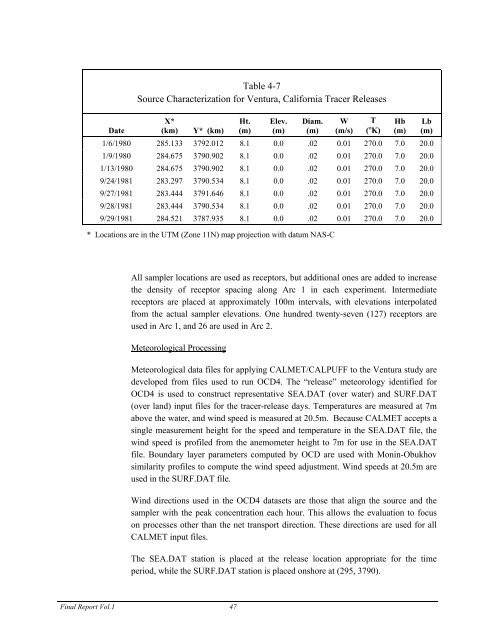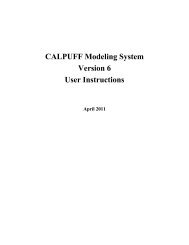Volume 1 - The Atmospheric Studies Group at TRC
Volume 1 - The Atmospheric Studies Group at TRC
Volume 1 - The Atmospheric Studies Group at TRC
Create successful ePaper yourself
Turn your PDF publications into a flip-book with our unique Google optimized e-Paper software.
Table 4-7<br />
Source Characteriz<strong>at</strong>ion for Ventura, California Tracer Releases<br />
D<strong>at</strong>e<br />
X*<br />
(km) Y* (km)<br />
Ht.<br />
(m)<br />
Elev.<br />
(m)<br />
Diam.<br />
(m)<br />
W<br />
(m/s)<br />
T<br />
(ºK)<br />
Hb<br />
(m)<br />
Lb<br />
(m)<br />
1/6/1980 285.133 3792.012 8.1 0.0 .02 0.01 270.0 7.0 20.0<br />
1/9/1980 284.675 3790.902 8.1 0.0 .02 0.01 270.0 7.0 20.0<br />
1/13/1980 284.675 3790.902 8.1 0.0 .02 0.01 270.0 7.0 20.0<br />
9/24/1981 283.297 3790.534 8.1 0.0 .02 0.01 270.0 7.0 20.0<br />
9/27/1981 283.444 3791.646 8.1 0.0 .02 0.01 270.0 7.0 20.0<br />
9/28/1981 283.444 3790.534 8.1 0.0 .02 0.01 270.0 7.0 20.0<br />
9/29/1981 284.521 3787.935 8.1 0.0 .02 0.01 270.0 7.0 20.0<br />
* Loc<strong>at</strong>ions are in the UTM (Zone 11N) map projection with d<strong>at</strong>um NAS-C<br />
All sampler loc<strong>at</strong>ions are used as receptors, but additional ones are added to increase<br />
the density of receptor spacing along Arc 1 in each experiment. Intermedi<strong>at</strong>e<br />
receptors are placed <strong>at</strong> approxim<strong>at</strong>ely 100m intervals, with elev<strong>at</strong>ions interpol<strong>at</strong>ed<br />
from the actual sampler elev<strong>at</strong>ions. One hundred twenty-seven (127) receptors are<br />
used in Arc 1, and 26 are used in Arc 2.<br />
Meteorological Processing<br />
Meteorological d<strong>at</strong>a files for applying CALMET/CALPUFF to the Ventura study are<br />
developed from files used to run OCD4. <strong>The</strong> “release” meteorology identified for<br />
OCD4 is used to construct represent<strong>at</strong>ive SEA.DAT (over w<strong>at</strong>er) and SURF.DAT<br />
(over land) input files for the tracer-release days. Temper<strong>at</strong>ures are measured <strong>at</strong> 7m<br />
above the w<strong>at</strong>er, and wind speed is measured <strong>at</strong> 20.5m. Because CALMET accepts a<br />
single measurement height for the speed and temper<strong>at</strong>ure in the SEA.DAT file, the<br />
wind speed is profiled from the anemometer height to 7m for use in the SEA.DAT<br />
file. Boundary layer parameters computed by OCD are used with Monin-Obukhov<br />
similarity profiles to compute the wind speed adjustment. Wind speeds <strong>at</strong> 20.5m are<br />
used in the SURF.DAT file.<br />
Wind directions used in the OCD4 d<strong>at</strong>asets are those th<strong>at</strong> align the source and the<br />
sampler with the peak concentr<strong>at</strong>ion each hour. This allows the evalu<strong>at</strong>ion to focus<br />
on processes other than the net transport direction. <strong>The</strong>se directions are used for all<br />
CALMET input files.<br />
<strong>The</strong> SEA.DAT st<strong>at</strong>ion is placed <strong>at</strong> the release loc<strong>at</strong>ion appropri<strong>at</strong>e for the time<br />
period, while the SURF.DAT st<strong>at</strong>ion is placed onshore <strong>at</strong> (295, 3790).<br />
Final Report Vol.1 47







